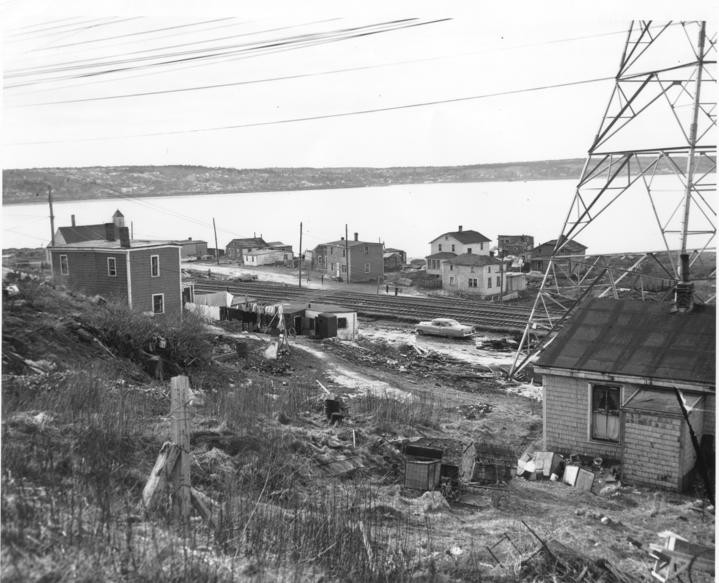What makes a good institutional apology?
Public apologies are virtually meaningless without an action to follow, experts say

caption
Africville, a black community in Halifax, was destroyed by the city. The mayor apologized for this in 2010. (Photo taken in 1965.)“I’m sorry” is what we say when we hurt someone.
Increasingly, we’ve been hearing it from institutions like governments and police agencies after acknowledging systemic oppression — oppression that often caused generational harm.
Last week, Halifax Regional Police Chief Dan Kinsella stood in front of members of the African Nova Scotian community to apologize for racist street check practices. Community members and activists were invited to hear Kinsella say “I’m sorry.”
But is an apology enough? Related stories
Karina Schumann, a psychology professor at the University of Pittsburgh and an expert in conflict resolution, says for public apologies, there is a default perception that they are insincere.
In order for these apologies to be effective, they need to have features that show what Schumann believes is most important: remorse.
Institutions making an apology must acknowledge “these are ongoing problems with ongoing consequences, and that the victimized group continues to suffer,” she says.
Canada’s first public government apology happened in 1988, made by the prime minister at the time, Brian Mulroney, for the internment of Japanese-Canadians during the Second World War.
Since then, there have been 13 government apologies, six of which were made in the last three years, by Prime Minister Justin Trudeau.
While there is no tangible way to compensate suffering under the hands of the government, Schumann says even a symbolic gesture can make it seem more meaningful.
What makes a good apology?
John Kador, author of the book Effective Apology, says apologies without actions are “virtually meaningless.”
Kador has a five-step model to an effective apology. He calls them “the five Rs”:
- Recognition: state the offence in detail,
- Responsibility: accept responsibility for the wrongdoing,
- Regret: make a statement of regret, specifically the words “I’m sorry,”
- Remorse: state the offence is wrong and was always wrong,
- Reparation: implement a practical step the institution takes after the apology.
“Victims want their pain to be acknowledged,” says Kador, but without ongoing reparation, the effects of the apology are diminished.
Receiving an apology
In 2008, former prime minister Stephen Harper made an apology to survivors and descendants of survivors of the Indian residential school system. In the apology, he acknowledged that over 150,000 children were separated from their parents and suffered abuse.
The apology promised fostering a new relationship “between Aboriginal peoples and other Canadians.”
Margaret (Magit) Poulette, of We’koqma’q First Nation, says the apology was “just words. Nothing has really changed.”
Poulette spent four years at the Shubenacadie Indian Residential School, from 1947 to 1951. At just four years old, she was taught to forget her language and her culture.
Her daughter, Rosie Sylliboy, says her mother’s trauma was passed on to her.
“When we were growing up, we were never hugged,” Sylliboy says. “I love my mother, but I hate what she went through.”
While the apology didn’t mean a lot to her or Poulette, Sylliboy says the acknowledgment of the offence mattered.
A more meaningful moment for the community, Sylliboy believes, was last year’s special Treaty Day mass at St. Mary’s Basilica in Halifax. Poulette is Roman Catholic.
On Oct. 2, 2018, a Catholic archbishop knelt in front of a congregation of residential school survivors and descendants, and asked for forgiveness for the church’s involvement in the Shubenacadie Indian Residential School.
“I cried through it,” says Sylliboy.
A psychological study by Matthew Hornsey on public apology perception showed that non-verbal signs of remorse, such as kneeling and crying, had positive effects on “perceived likelihood of reoffending, empathy, positive appraisals of the transgressor, and satisfaction with the apology.” It also showed that signs of remorse did not significantly affect forgiveness.
A part of Sylliboy’s family’s healing is reclaiming traditional songs and practices. She has also seen some priests practice traditions, like smudging at funerals. “That’s really reconciliation,” she says, though notes that their local church still doesn’t allow drumming inside.
Psychologist Schumann said people can accept an apology without forgiveness.
In 2010, former Halifax mayor Peter Kelly apologized to former residents and descendants of Africville, a black community in Halifax demolished in the 1960s.
Forgiveness is for the community
Rhonda Britton, pastor of New Horizons Baptist Church, was invited to Kelly’s apology ceremony. She was also invited to speak at the Halifax Regional Police’s apology for street check practices that disproportionately affected black men.
Britton believes institutional apologies are meaningful when leaders meet with members of the community and listen to their demands. She says forgiveness is not for the institution apologizing, but for the community.
“It was necessary,” she says about the police’s apology. “When these things happen in the public sphere, it also gives you a leg to stand on.”
When someone wants to make a complaint, Britton says, “no one can deny the fact that (the institution) has admitted this is wrong.”
Kador, the author of Effective Apology, says being complicit in systemic racism, and other kinds of oppressions, is something people don’t want to admit to, but victims want their pain acknowledged.
The real power of institutional apologies, he says, is “they require people to confront very difficult truths.”
About the author
Karla Renic
Karla Renic is a multimedia journalist in her fourth year at the University of King's College. She freelances and works as the news editor at...
